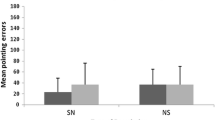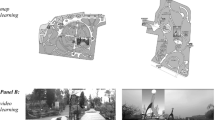Abstract
Mental imagery plays a crucial role in several cognitive processes, including human navigation. According to the Kosslyn’s Model, mental imagery is subserved by three components: generation, inspection and transformation. The role of transformation, where by individuals recognise, from a different perspective, a place they have already visited, is no longer a matter of debate. However, the role of the other two components when recalling a map from different perspectives, has never been fully investigated. In the present study, we enrolled forty-nine college students and asked them to learn a schematic map and to provide directional judgements aligned or counter-aligned compared to the learnt map orientation. Their mental imagery generation, inspection and transformation skills were also investigated. Results demonstrated that all three visual mental imagery components negatively correlate with errors in providing directional judgements. Specifically, generation assumes a role in aligned directional judgements, while inspection and transformation predict the capability to provide counter-aligned directional judgements. Although all mental imagery components play a role in mentally recalling a map, only the proficiency in inspection and mental rotation can predict the accuracy in changing perspective.




Similar content being viewed by others
References
Bianchini F, Incoccia C, Palermo L, Piccardi L, Zompanti L, Sabatini U, Peran P, Guariglia C (2010) Developmental topographical disorientation in a healthy subject. Neuropsychologia 48:1563–1573
Bianchini F, Palermo L, Piccardi L, Incoccia C, Nemmi F, Sabatini U, Guariglia C (2014) Where am I? A new case of developmental topographical disorientation. J Neuropsychol 8:107–124
Bisiach E, Luzzatti C (1978) Unilateral neglect of representational space. Cortex 14:129–133
Bluestein N, Acredolo L (1979) Developmental changes in map-reading skills. Child Dev 5O:691–697
Boccia M, Piccardi L, Palermo L, Nemmi F, Sulpizio V, Galati G, Guariglia C (2014) One’s own country and familiar places in the mind’s eye: different topological representations for navigational and non-navigational contents. Neurosci Lett 579:52–57
Boccia M, Piccardi L, Palermo L, Nemmi F, Sulpizio V, Galati G, Guariglia C (2015) A penny for your thoughts! Patterns of fMRI activity reveal the content and the spatial topography of visual mental images. Hum Brain Map 36:945–958
Boccia M, Sulpizio V, Palermo L, Piccardi L, Guariglia C, Galati G (2017) I can see where you would be: patterns of fMRI activity reveal imagined landmarks. Neuroimage 144:174–182
Committeri G, Piccardi L, Galati G, Guariglia C (2015) Where did you “left” Piazza del Popolo? At your “right” temporo-parietal junction. Cortex 73:106–111
Galea LAM, Kimura D (1993) Sex differences in route learning. Pers Indiv Diff 14:53–65
Guariglia C, Piccardi L (2010) Environmental orientation and navigation in different forms of unilateral neglect. Exp Brain Res 206:163–169
Guariglia C, Palermo L, Piccardi L, Iaria G, Incoccia C (2013) Neglecting the left side of a city square but not the left side of its clock: prevalence and characteristics of representational neglect. PLoS ONE 8:e67390
Iaria G, Incoccia C, Piccardi L, Nico D, Sabatini U, Guariglia C (2005) Lack of orientation due to a congenital brain malformation: a case study. Neurocase 11:463–474
Iaria G, Bogod N, Fox CJ, Barton JJS (2009) Developmental topographical disorientation: case one. Neuropsychologia 47:30–40
Kosslyn SM (1980) Image and mind. Harvard University Press, Cambridge
Kosslyn SM (2005) Mental images and the brain. Cogn Neuropsychol 22:333–347
Landau B, Lakusta L (2009) Spatial representation across species: geometry, language and maps. Curr Op Neurobiol 19:12–19
McNamara TP, Rump B, Wemer S (2003) Egocentric and geocentric frames of reference in memory of large-scale space. Psychon Bull Rev 10:589–595
Newman EL, Caplan JB, Kirschen MP, Korolev IO, Sekuler R, Kahana MJ (2007) Learning your way around town: how virtual taxicab drivers learn to use both layout and land- mark information. Cognition 104:231–253
Nori R, Giusberti F (2003) Cognitive styles: errors in the directional judgements. Perception 32:307–320
Nori R, Giusberti F (2006) Predicting cognitive styles from spatial abilities. Am J Psychol 119:67–86
Nori R, Piccardi L (2011) Familiarity and spatial cognitive style: how important are they for spatial representation? In: Thomas JB (ed) Spatial memory: visuospatial processes, cognitive performance and developmental effects. Nova Science, New York, pp 123–144
Nori R, Iachini T, Giusberti F (2004) Object localisation and frame of reference. Cogn Process 5:45–53
Nori R, Grandicelli S, Giusberti F (2006) Alignement effect: primary-secondary learning and cognitive style. Perception 35:1233–1249
Nori R, Piccardi L, Palermo L, Guariglia C, Giusberti F (2012) Working memory load elicits gender differences in mental imagery. In: McGeown SP (ed) Psychology of gender differences. Nova Science Publishers Inc., New York, pp 164–174
Palermo L, Iaria G, Guariglia C (2008) Mental imagery skills and topographical orientation in humans: a correlation study. Behav Brain Res 192:248–253
Palermo L, Piccardi L, Nori R, Giusberti F, Guariglia C (2010a) Does hemi-neglect affect visual mental imagery? Imagery deficits in representational and perceptual neglect. Cogn Neuropsychol 27:115–133
Palermo L, Nori R, Piccardi L, Giusberti F, Guariglia C (2010b) Environment and object mental images in patients with representational neglect: two case reports. JINS 16:921–932
Palermo L, Piccardi L, Bianchini F, Nemmi F, Giorgio V, Incoccia C, Sabatini U, Guariglia C (2014) Looking for the compass in a case of developmental topographical disorientation: a behavioral and neuroimaging study. J Clin Exp Neuropsychol 36:464–481
Palermo L, Piccardi L, Nori R, Giusberti F, Guariglia C (2016) The impact of ageing and gender on visual mental imagery processes: a study of performance on tasks from the Complete Visual Mental Imagery Battery (CVMIB). J Clin Exp Neuropsychol 38:752–763
Palmiero M, Nori R, Aloisi V, Ferrara M, Piccardi L (2015) Domain-specificity of creativity: a study on the relationship between visual creativity and visual mental imagery. Frontiers Psychol 6:01870
Pazzaglia F, De Beni R (2001) Strategies of processing spatial information in survey and landmark-centred individuals. Eu J Cogn Psychol 13:493–508
Pazzaglia F, De Beni R (2006) Are people with high and low mental rotation abilities differently susceptible to the alignment effect? Perception 35:369–383
Pearson J, Kosslyn SM (2013) Mental imagery. Front Psychol 4:198
Piccardi L, Bianchini F, Zompanti L, Guariglia C (2008) Pure representational neglect and navigational deficits in a case with preserved visuo-spatial working memory. Neurocase 14:329–342
Piccardi L, Risetti M, Nori R (2011a) Familiarity and environmental representations of a city: a self-report study. Psychol Rep 109:309–326
Piccardi L, Risetti M, Nori R, Tanzilli A, Bernardi L, Guariglia C (2011b) Perspective changing in primary and secondary learning: a gender difference study. Learn Indiv Diff 21:114–118
Piccardi L, Nori R, Palermo L, Guariglia C, Giusberti F (2015) Age effects in generating mental images of buildings but not common objects. Neurosci Lett 602:79–83
Presson CC, Hazelrigg MD (1984) Building spatial representations through primary and secondary learning. J Exp Psychol Learn Mem Cogn 10:716–722
Prestopnik JL, Roskos-Ewoldsen B (2000) The relations among way findings strategy use, sense of direction, sex, familiarity, and way finding ability. J Environ Psychol 20:177–191
Shepard RN, Metzler J (1971) Mental rotation of three-dimensional objects. Science 171:701–703
Siegel AW, White SH (1975) The development of spatial representations of large-scale environments. In: Reese HW (ed) Advances in child development and behavior, vol 10. Academic Press, Cambridge, pp 9–55
Verde P, Piccardi L, Bianchini F, Trivelloni P, Guariglia C, Tomao E (2013) Gender effects on mental rotation in pilots vs. nonpilots. Aviat Space Environ Med 84:726–729
Warren DH, Scott TE (1993) Map alignment in travelling multisegment routes. Environ Behav 25:131–150
Author information
Authors and Affiliations
Corresponding author
Rights and permissions
About this article
Cite this article
Piccardi, L., Bocchi, A., Palmiero, M. et al. Mental imagery skills predict the ability in performing environmental directional judgements. Exp Brain Res 235, 2225–2233 (2017). https://doi.org/10.1007/s00221-017-4966-8
Received:
Accepted:
Published:
Issue Date:
DOI: https://doi.org/10.1007/s00221-017-4966-8




